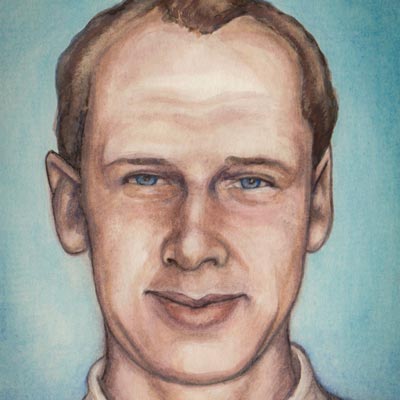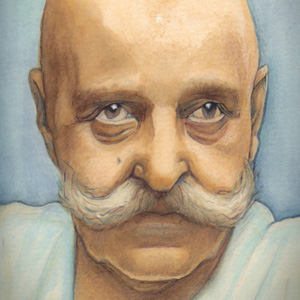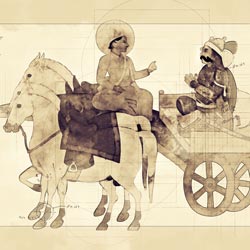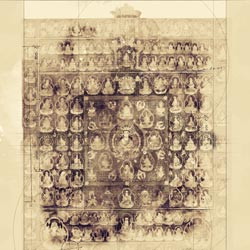
Rodney Collin (26 April 1909–3 May 1956) was a writer and thinker connected with the Fourth Way tradition, taught to him by his beloved teacher and mentor, the late P.D. Ouspensky. Before finding the Work, Collin grew up in Brighton, England and attended the London School of Economics. He worked for the British Census Office and wrote for various other publications. The scope of his thoughts and understanding was monumental and synthetic. He arrived at a picture of the sequence of civilizations within world history that included both technological and moral development in humankind. His unique understandings of time and interpretations of ancient mythology and art are also noteworthy.
Rodney Collin did much to materialize the aim of his teacher to integrate modern science with ancient wisdom, a process he correlated with the difference and relationship between laws and facts or deductive and inductive reasoning. Rodney Collin passed away in Cuzco, Peru where he and some students had traveled to work on publishing, theatre, and establishing a school on a continent that they believed would be the birthplace of a new spiritual civilization. His legacy continues in his classic and intellectually generous books The Theory of Celestial Influence, The Theory of Eternal Life, and The Theory of Conscious Harmony, published posthumously from the author’s notes and letters.
Rodney Collin on the Triad of Self-Remembering
Mr. Collin shared the practical and utilitarian spirit of his instructors in the Fourth Way. Although a brilliant thinker and adept in areas of theory and philosophy, he faithfully connected each aspect of information presented, whether in science, mathematics, etc., with work on oneself. A significant contribution in this connection made by Rodney Collin to the Fourth Way canon was the idea of the triad of self-remembering. In the teaching given by Gudjieff there were two universal laws: three and seven. Each phenomenon, in order to exist, must abide by these two laws. In the case of the law of three, this means that everything in the universe must consist of at least three forces: active, passive, and neutral. Because the state of self-remembering, which is the core practice of this teaching, exists as a definite and measurable psychological condition, it must similarly consist of three parts, although these had not subsequently been formulated. Collin determined that if self-remembering was defined by divided attention, keeping a ratio of one’s attention between oneself and the environment, there must be a third force overseeing these two; this he called God and symbolized by the sun. He likened this to the Holy Trinity, as he delicately and articulately connected many ideas from the system of the Work, along with Dr. Nicoll, to Judeo Christian teaching, catalyzed by the particular religious tradition of the West and by Mr. Gurdjieff’s auxiliary definition of the Fourth Way as esoteric Christianity.
Collin on the Enneagram
A symbol introduced by Gurdjieff to the modern West called the Enneagram or nine pointed star (ennea=nine, gramma=written) arranges the digits 1 -10 along a circle while indicating the inner relationships and progressions among these numbers using shapes that represent the laws of three and seven. The law of three states that each event is a combination of three different forces and the law of seven or law of octaves determines the progression of each event in time. The law of seven contains the idea that all phenomena vibrate internally with a certain music that can ascend or descend with exact knowledge of “chords” that produce harmony. Plato also mentioned this musical idea in reference to the planets and also to the human soul. It is likely that the musical scale itself was originally a formulaic representation of observed planetary movement.
Gurdjieff claimed that a deep understanding of this figure would unlock the secrets of the universe and that all knowledge could be stored along its lines and points. Rodney Collin, as Ouspensky, used the enneagram to plot and explain numerous phenomena in nature such as growth in man, the development of human civilization, planetary and solar rotations, and the essence of time itself. He believed that the connections revealed by the internal depths of the numerical relationships on this symbol accounted for and could be used to logistical gaps and processes hitherto deemed mysterious by modern scientific understanding. Essentially, Collin attempted to illustrate the various invisible chords linking events in time and space that either appear to be disparate or conversely seem strangely connected. In this way, he provided a manner of understanding relativity or the view of things in the world from a higher or fourth dimensional perspective.
Collin on the Logarithmic Scale
Additionally, Collin anticipated trends in using logarithmic or exponential calculation to understand speeds in development of organic and inorganic processes and to predict their outcome. He diligently plotted the stages of physical and cognitive growth in humans along a logarithmic scale and sought to alter natural intuition about the linearity of one’s lifetime. Processes begun with great speed gradually become slower and slower and are gradually replaced by evolutionary emphasis upon subtler and more intelligent functions. Each step or stage is built upon the last and is dependant upon it successful completion and release of force or energy. Retardations or arrestments in lower functioning due to trauma or insufficient nourishment will cancel possibilities in higher functioning like a damaged seed that cannot bear fruit or an intellect that is too noisy or contradicted to perceive stillness or acquire peace. He arranged the relationships between these separate time scales upon a three dimensional figure consisting of two infinity symbols linked at their midpoints. Each circle represented the complete time of its antecedent contained within one unit of its own progression. Once the passage from one cycle to the next was accomplished, activity in the previous circle was locked and fixed like the form of water when crystallized into ice at the exact temperature where liquid becomes solid.
Rodney Collin on Mineral, Cellular, Molecular & Electronic Worlds
For the purpose of achieving a meaningful synthetic link with scientific nomenclature Collin assigned these various time scales the terms mineral, cellular, molecular, electronic by virtue of their speed and length of lifetime. Physical processes in man he corresponded with mineral and cellular growth whereas cognitive and spiritual unfolding with that of the molecular and electronic worlds. In a mood of scientific and religious valency that characterizes Collin’s writings, an analogy between these different material distinctions and the judgement of the soul after death and its journey into the realms of paradise, heaven, and hell was made. As microcosmic man, we technically have access to all these places and levels of density within ourselves and Mr. Collin, as Mr. Ouspensky, always stressed the value of practical methods of developing consciousness in the more rarefied reaches of our internal atmosphere and ecosystem.
Collin on the Six Processes
Derived from Ouspensky’s six dimensional model of the universe and the laws of the Ray of Creation, Collin describes six fundamental processes contained within each complete cosmos. In specific relation to our particular situation as humans, he organizes each process as a different arrangement of the sun, planets, and earth, or life, form, and matter. Mr. Ouspensky, at the end of his life began to explain these six kinds of activity into which every action can be classified, but Collin carried this metaphor much further, looking in detail about what each process means and giving many nuanced examples.
Collin on Glands and Planetary Types
Collin, inspired by medieval alchemy and medicine and also the work of Dr. Berman, linked each gland in the human endocrine system with the influence of a particular planet. By assigning dominant centers of gravity of different people in distinct glandular manefestations, he arrived at six central planetary types and variable subdivisions thereof. This teaching can be quite useful in the task oriented group dynamics that characterize the Fourth Way schools and was developed even more completely in Mr. Burton’s teaching.
Rodney Collin on the Fourth Way
.
Frequently Asked Questions
Who was Rodney Collin?
– A British writer, philosopher, and disciple of P.D. Ouspensky.
– A gifted synthesizer of science, religion, art, and esoteric psychology.
– Known for his profound books, especially The Theory of Celestial Influence, The Theory of Conscious Harmony, and The Theory of Eternal Life.
– A key figure in expanding and deepening the Fourth Way after Ouspensky’s death.
– He died in Cuzco, Peru, while attempting to help establish a Fourth Way school in South America.
His writings are highly imaginative yet structured, filled with metaphysical insight, scientific analogy, and spiritual synthesis.
How was Rodney Collin connected to P.D. Ouspensky and the Fourth Way?
– After Ouspensky’s death in 1947, Collin traveled to Lyne Place and recorded many of the last teachings and moments of Ouspensky’s life.
– He believed that Ouspensky had reached a higher state before death and that the task of continuing the Fourth Way legacy fell to him.
– Collin helped bridge the work between Ouspensky’s intellectual clarity and Gurdjieff’s mystical impulse, infusing it with his own visionary scope.
What is Rodney Collin’s book The Theory of Celestial Influence about?
It explores:
– The structure of the cosmos (using Gurdjieff’s “Ray of Creation” and planetary models).
– How different time-scales and worlds (mineral, cellular, molecular, electronic) relate to states of consciousness.
– The evolution of civilizations and religions, placed on a logarithmic scale of development.
– How the laws of three and seven play out in the unfolding of human history and psychology.
– The interconnectedness of all things through vibration, octave laws, and celestial rhythms.
“Rodney Collin attempted to illustrate the various invisible chords linking events in time and space that either appear to be disparate or conversely seem strangely connected.” It’s not light reading, but it’s immensely rich, oƯering a map of how the universe mirrors man and vice versa.
What were Rodney Collin's main ideas or contributions to the Fourth Way?
– Expanded Cosmology – He added depth to Gurdjieff’s cosmological ideas, showing how the same laws govern galaxies, civilizations, and inner states.
– Gland–Planet Typology – Collin connected the human endocrine system to planetary influences, defining six major personality types (e.g., solar, lunar, mercurial types) and explaining their spiritual implications.
– Time and Higher Dimensions – He described time as multi-dimensional (borrowing from Ouspensky’s ideas of higher dimensions) and emphasized that we live in multiple scales of time simultaneously.
– Six Fundamental Processes – Collin explored six universal types of processes (based on different cosmic configurations), helping categorize how change occurs in nature and people.
– Christian Esotericism – Like Nicoll, he reinterpreted Christian teachings, viewing the Trinity, resurrection, and parables as inner psychological realities.
– The Triad of Self-Remembering – He uniquely described self-remembering as a three-force phenomenon:
You (the observer)
What is observed
A third force (the Sun or God) that connects the two.
“Because self-remembering is a definite and measurable psychological condition, it must consist of three parts.” – Collin
How does Rodney Collin’s work differ from or expand upon Ouspensky’s teachings?
– Ouspensky was focused on psychological transformation | Collin added a rich cosmic direction and historical cycles
– Ouspensky was concerned with rigor and verification | Collin withdrew from Gurdjieff’s mystical direction
– Ouspensky did not teach after Gurdjieff’s death | Collin was more open to inspiration, metaphysics, and symbolic logic. He embraced and revived that mystical side with his own style. He actively tried to continue the work through writing and action (e.g. the Peru project)
Rodney Collin essentially built a bridge between the scientific mind and the mystical heart of the Fourth Way.
“He stood at the intersection of science and spirit, reason and revelation.” – Document

In 2022/24, the School of the Old New Method created a full-length documentary on George Gurdjieff.





